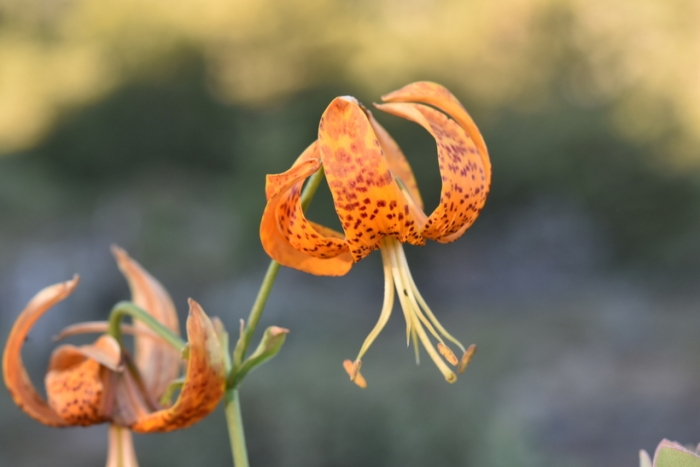Humboldt’s Lily
(Lilium humboldtii)
Humboldt’s Lily (Lilium humboldtii)
/
/

Joey Malone
CC BY 3.0
Image By:
Joey Malone
Recorded By:
Copyright:
CC BY 3.0
Copyright Notice:
Photo by: Joey Malone | License Type: CC BY 3.0 | License URL: http://creativecommons.org/licenses/by/3.0/ | Attribution: 2017 Joey Malone | Publisher: Calphotos |

























































Estimated Native Range
Summary
Lilium humboldtii, commonly known as Humboldt’s Lily, is a deciduous perennial herb native to the chaparral, oak woodlands, and mixed evergreen forests of California and Northwestern Mexico. It can reach up to 6 feet (1.8 m) in height and is notable for its striking flowers, which are maroon-spotted, golden-orange with dark red splotches, and have orange to brown stamens. The flowers, which are quite showy, appear in June in a pyramidal inflorescence atop stout, sometimes brown-purple stems. The large subrhizomatous bulb has yellowish-white scales and is deeply buried in the soil. The leaves are arranged in whorls, undulate, shiny, and oblanceolate. After its flowering period in mid- to late summer, the plant becomes summer-deciduous, dying back until the next growing season.
Humboldt’s Lily is valued for its spectacular flowers and is used in cultivation for ornamental purposes, including border plantings and as a garden bulb. It is adapted to Mediterranean climates and requires a dry summer dormancy, with no water after blooming to mimic its native habitat conditions. This species thrives in part shade, though it can also tolerate full sun, and it prefers soils with good drainage. While it is relatively low maintenance, it is important to avoid overwatering, especially during its dormant period. The Bellingham hybrid lilies, including the popular ’Shuksan’ and ’Star of Oregon’ cultivars, owe their existence to the genetic contributions of Lilium humboldtii. Potential problems include susceptibility to lily beetle infestations and fungal diseases if conditions are too moist.CC BY-SA 4.0
Humboldt’s Lily is valued for its spectacular flowers and is used in cultivation for ornamental purposes, including border plantings and as a garden bulb. It is adapted to Mediterranean climates and requires a dry summer dormancy, with no water after blooming to mimic its native habitat conditions. This species thrives in part shade, though it can also tolerate full sun, and it prefers soils with good drainage. While it is relatively low maintenance, it is important to avoid overwatering, especially during its dormant period. The Bellingham hybrid lilies, including the popular ’Shuksan’ and ’Star of Oregon’ cultivars, owe their existence to the genetic contributions of Lilium humboldtii. Potential problems include susceptibility to lily beetle infestations and fungal diseases if conditions are too moist.CC BY-SA 4.0
Plant Description
- Plant Type: Herb
- Height: 1-3 feet
- Width: 1-3 feet
- Growth Rate: Moderate
- Flower Color: Orange
- Flowering Season: Spring, Summer
- Leaf Retention: Deciduous
Growth Requirements
- Sun: Full Sun, Part Shade
- Water: Low, Very Low
- Drainage: Fast
Common Uses
Bee Garden, Bird Garden, Butterfly Garden, Drought Tolerant, Fragrant, Hummingbird Garden, Low Maintenance, Showy Flowers
Natural Habitat
Native to chaparral, oak woodlands, and mixed evergreen forests
Other Names
Common Names: Humboldt Lily
Scientific Names: , Lilium humboldtii,
GBIF Accepted Name: Lilium humboldtii W.Bull